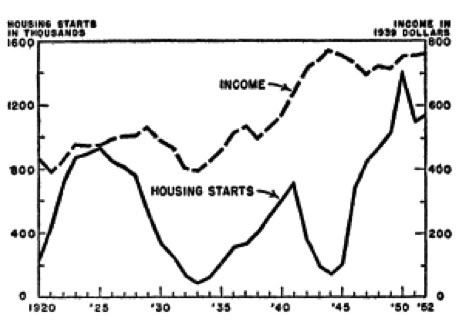I wanted to memorialize some information I came across as a result of correspondence with Calculated Risk pursuant to his post the other day entitled Show Me the Engines of Growth, in which he said, "Housing usually leads the economy both into and out of recessions (this was true for the Great Depression too)."
Both CR and I have relied significantly on a presentation Prof. David Leamer made at the Jackson Hole conference a couple of years ago, in which he discussed the importance of housing to the business cycle (but unbelievably failed to see just how crucial a role housing was going to play in this downturn!). Prof. Leamer showed convincingly that post-WW2 recessions all were led by significant housing downturns, and that housing, relatively speaking, was the first industry to turn up, presaging the end of those recessions.
Prof. Leamer, intriguingly, made an aside about housing during the Roaring Twenties and Great Depression, showing a graph from a 1954 text which appeared to show that the busting of a housing bubble also previewed the Great Depression. Here's the graph:

Up until the other day, I had been unable to verify the information in that graph, or the source of the information, but in the course of my exchange with CR, I found this source which did indeed come from the Department of Labor, and gave exact annual data for "non farm housing starts". Using that data, I have been able to generate this chart, which also in the last column converts the equivalent housing starts to our time, by multiplying the data proportionate to the population for each year compared with our modern population of 300 million. All data is in 1000's:
| Year | Nonfarm housing starts | 2009 equivalent |
|---|---|---|
| 1920 | 247 | 699 |
| 1921 | 449 | 1236 |
| 1922 | 716 | 1953 |
| 1923 | 371 | 994 |
| 1924 | 893 | 2350 |
| 1925 | 937 | 2423 |
| 1926 | 849 | 2177 |
| 1927 | 810 | 2042 |
| 1928 | 753 | 1867 |
| 1929 | 509 | 1252 |
| 1930 | 330 | 805 |
| 1931 | 254 | 615 |
| 1932 | 134 | 322 |
| 1933 | 93 | 221 |
| 1934 | 126 | 300 |
| 1935 | 221 | 522 |
| 1936 | 319 | 748 |
| 1937 | 336 | 781 |
| 1938 | 406 | 937 |
| 1939 | 515 | 1179 |
| 1940 | 602 | 1368 |
Bear in mind the following two facts:
1. the peak housing starts during the recent bubble were 2273 in the month of January. 2006, and have since fallen to ~500.
2. The above figures are for nonfarm housing starts only. In 1930, 25% of the US population lived on farms, compared with only 2% today.
So if anything, the 1920s boom was much more of a bubble than the recent one, and perhaps the ensuing decline, while much more drastic over the 3 1/2 years since than the eight year decline from 1925-1933, will not sink so low before bottoming.
CR's conclusion was that it looked like housing led the way out of the Great Depression. That seems a little too strong for me. Certainly it does not appear that any month in 1932 would have been a candidate for the housing bottom. The contraction phase of the Great Depression ended in April 1933, so at best housing may have led by a couple of months. More likely, one suspects, is that once FDR and the Emergency Banking Acts of April 1033 restored confidence to the banking system, mortgages became more available, and so housing bottomed in the spring or early summer of 1933, improving slowly thereafter, generally coincident with the recovery phase from the Great Depression.
Housing starts in recent months have seemed generally to move sideways, but they did the same thing last year, before collapsing again in the last 6 months of 2008. If housing does "lead the way" out of this Recession, it is likely to be a very subdued advance.